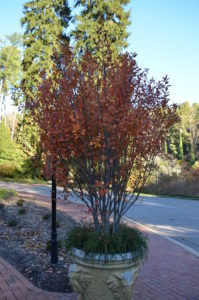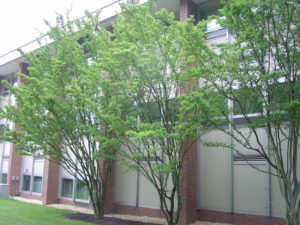Serviceberry (Amelanchier arborea) is a medium-sized native tree. Its native range stretches from Ontario to the Gulf Coast (USDA hardiness zones 4-9). However, it performs well across the Western and Central U.S. Serviceberry is regionally known by many names, including shadbush, shadblow, sarvisberry, sarvis tree, and Juneberry. The latter refers to the small greenish-blue, ripening red fruits in late May here in East Tennessee (USDA hardiness zones 6 and 7).
A frosty sighting on a mountainside in an early spring morn is likely serviceberry in bloom. Serviceberry’s small white blooms signals that the winter season is coming to an end. Flowering usually lasts 7-10 days. Its purple fruits attract multiples of birds. Soon thereafter, hundreds of seedlings will germinate in your landscape. In 5 to 6 years you may be enjoying a shade from one of these seedling trees.
The tree naturally develops multi-trunked unless trained as a single trunk tree at the nursery. Serviceberry can be utilized as a street tree and a yard tree. Leading cultivars (hybrids) are ‘Autumn Brilliance’, ‘Forest Prince’, ‘Princess Diana’ and ‘Robin Hill’. They’re listed as hybrid crosses (A. x grandiflora) and Downy serviceberry (A. arborea). Shrubby Allegheny serviceberry (A. laevis) is also commonly planted.
Annual growth rate is rapid, 20 to 30 feet tall and 15-20 feet wide in 20 years. Serviceberry tolerates many kinds of soils, preferring moist, acidic, well-drained soil, and partial to full day sun. Irrigate and mulch a newly planted tree until it is established. Within two years a tree can handle moderately dry spells. If pruning is needed, do so in the spring after flowering.
In most years, serviceberries suffer from few disease and pest issues. In a rare wet summer, severe leaf spotting may result in an early leaf loss in August and dash all hopes of fall color.
Serviceberry’s multi-trunked branching fashions a wonderful winter silhouette on a dreary snowy day.



 Posted in
Posted in 
